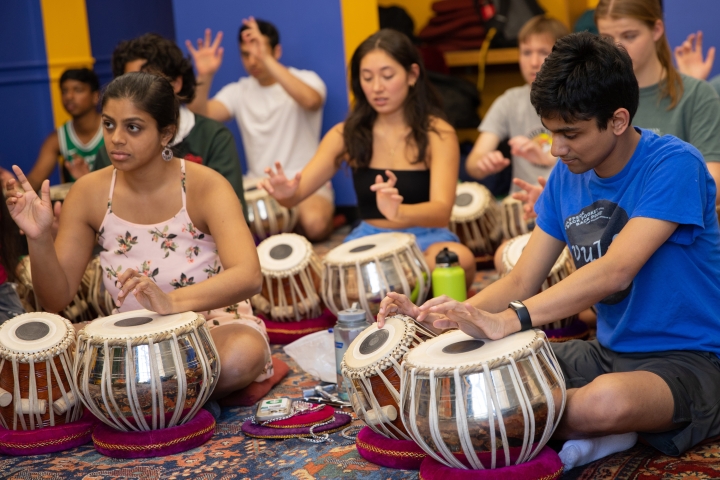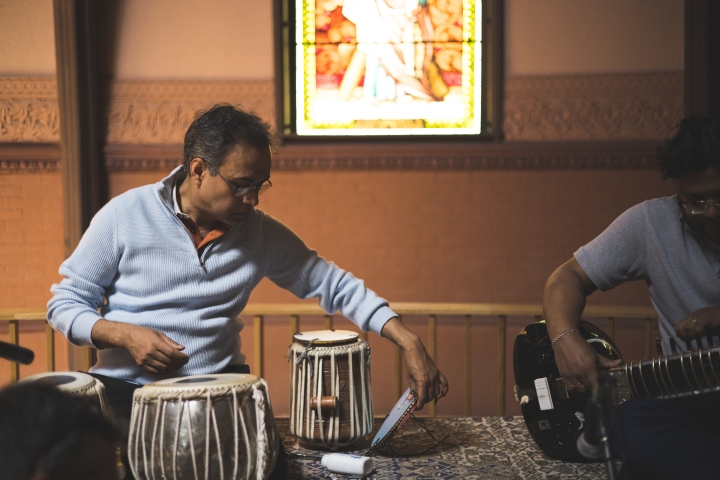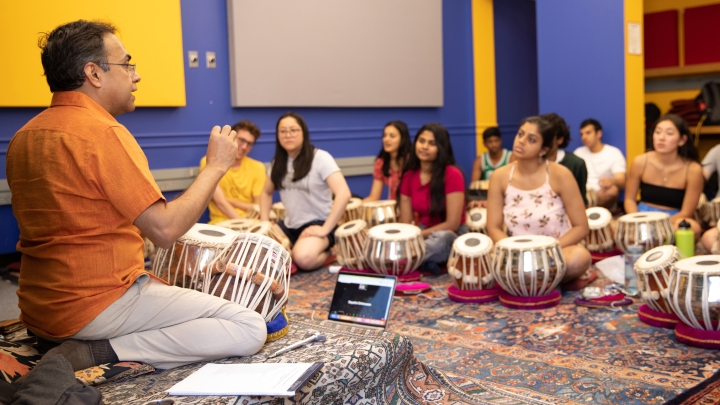Arts Everywhere: Winter at the Hop
When Grammy Award-winning musician Sandeep Das was a child, he couldn’t stop tapping.
Teachers in his native India grew frustrated with Das constantly tapping on his desk or tapping his feet. They wanted his parents to take Das to a doctor to see what was wrong.
Fortunately, his father imagined an alternative treatment. That very evening, when Das came home, a tabla—a traditional Indian set of paired hand drums—was sitting on the table, waiting for him.
That instrument would carry Das to international acclaim as a top percussion artist, to performances with the New York Philharmonic, and to collaborations with cellist Yo-Yo Ma. It’s also brought him to Dartmouth, where Das recently played a concert at the Hopkins Center for the Arts and is teaching a class with Ted Levin, the Arthur R. Virgin Professor of Music.
Levin, who chairs the Department of Music, says that despite Das’s fame, his teaching style is friendly, humorous, and self-deprecating. “At the same time, you realize that he’s got an enormous ability and talent to be able to use this instrument both in its traditional way as an instrument of Indian classical music, but also extending beyond that,” Levin adds.
Although Das is the only professional musician in his family, he comes from a family of music lovers. His earliest memories are of going to concerts or hosting musicians at their house. He fondly recalls sitting on top of a van at a music festival, eating and enjoying the performances before packing up and heading to another festival.
At age 7, he began intensive, one-on-one musical training with a guru, a teacher who acts as a guide in and beyond music.
“Music was being taught to us as a way of life,” Das says.
During his training, Das learned in an oral tradition, where he learned repertoire and concepts by listening to his guru vocalize tabla syllables, or bols, and memorizing them.
Das does not read music in the Western tradition; instead he draws upon these musical building blocks and compositional rules to improvise when performing.
This means that no two concerts are ever exactly the same. Before a performance, Das huddles with fellow musicians to get a feel for what they want to play.
“That’s also part of our tradition, that you decide the ingredients, get into the kitchen, and then you cook and you see what comes out,” Das says.
Das relates a lesson his guru explained to him: “My job is to fill your garage with any tools you might need, so that you can use them to keep building, keep growing, and keep expanding for the rest of your life.”
Das and Levin met when Levin was executive director of the Silk Road Project, an organization started by Yo-Yo Ma to bring together musicians from different traditions. Das was chosen as a founding member of the Silkroad Ensemble, which had its inaugural concert at Dartmouth in 2001.

Das has played at Dartmouth several times since, and he taught a class with Levin in 2016. Because of how much students enjoyed that class, Levin was eager to have Das return for another class, this one titled Music and Dance of North India.
The class looks different than many others taught at Dartmouth. Students sit on the floor instead of in chairs, and all 22 of them are equipped with tablas. There are no phones or computers. And nobody is allowed to take notes—the focus is on listening.
“We’re just sitting there with our tablas, listening and repeating,” Levin says.
While Levin plays a number of stringed instruments, the tabla is new to him, so he’s learning along with his students.
Some students are music majors, while others have never picked up an instrument. But the instructors are concerned with more than mastery of the tabla.
“It’s really a deep dive into an aspect of Indian culture and developing a respect and an understanding for some elements of it through the experience of learning about music,” Levin says.
Patrick Howard ’23 calls this one of his favorite classes he’s taken at Dartmouth.
“I’ve enjoyed everything about it,” Howard says in an email. “The communal atmosphere, the heavily interactive nature of the teaching, the hands-on course material, the challenge of reframing my understanding of music, our professors’ charisma and engagement, and the engagement and friendliness of my classmates.”
Howard, who sings with the Dartmouth Aires, plays guitar in the rock band Shark, and is minoring in music, credits Das with caring deeply for his students. When Howard asked a question about wrist technique in class, Das immediately adjusted his lecture to focus on that topic.
“The class serves as a great capstone to my time at Dartmouth,” Howard says. “I’ll keep that as one of my most positive memories of my last few weeks here.”

The Hopkins Center for the Arts welcomed Das on April 20 to Rollins Chapel, where he and the Hum Ensemble performed “a kaleidoscopic journey of music, dance, and storytelling.”
Titled Delhi to Kabul, it explores how music connects different people, a common thread in his work. The world premiere last week featured Indian as well as Afghan artists to illustrate the musical links that connect the two cultures.
Mary Lou Aleskie, the Howard Gilman ’44 Executive Director of the Hop, says the Hop is “a central partner with Sandeep in helping him realize his aspirations to transcend borders with his music. Since his early involvement as a founding member of the Silk Road Ensemble, Sandeep devoted his music to bridging cultures without diminishing the power of his own traditions.”
The ensemble, she notes, commissioned and toured numerous works throughout the world including at the Hopkins Center.
“Sandeep is now exploring ways to make the same kind of commitment to music as a cultural bridge of understanding beginning with his own traditions. ‘Delhi to Kabul’ is the latest effort in this work,” Aleskie says. “The Hopkins Center hosted the developmental workshop and premiere performance that will go on to travel the world with the hope that musical similarities will create deeper appreciation and understanding.”
Das said that during the performance of Delhi to Kabul, he wants the audience to absorb more than just the music.
“My biggest hope is they will see people of completely different backgrounds, caring for each other and respecting one another’s traditions and musical abilities,” Das says. “They will see how communication is happening with eyes, with bodies, with gestures, and with sounds. And they will see the joy of sharing and caring for one another.”


